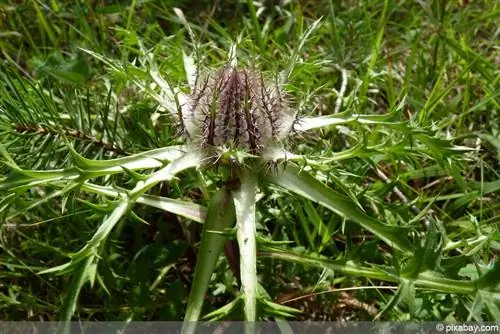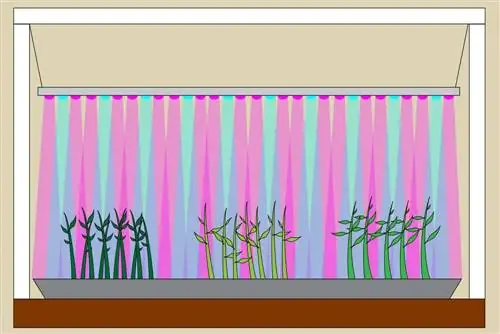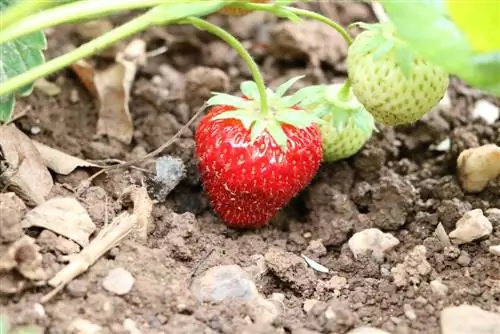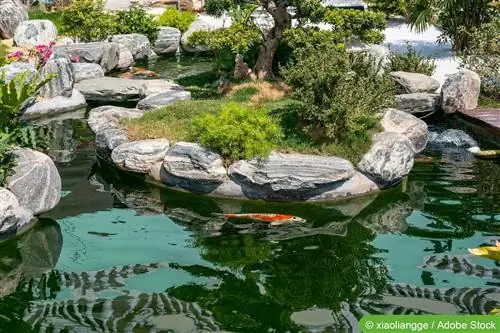- Author admin [email protected].
- Public 2023-12-17 03:39.
- Last modified 2025-01-24 12:45.
On poor meadows, in mountainous areas and on the edge of the forest, the silver thistle plant only occasionally decorates its surroundings. As rare as they are here, with the right care the plant can grow lushly in the garden and spread widely. It is not particularly demanding, but it still depends on the correct location and the appropriate measures to keep the perennial Carlina acaulis he althy with as little effort as possible.
Location
The silver thistle plant prefers sunny locations where it is warm and comparatively protected. Due to its maximum height of 30 centimeters, it doesn't require too much upward space. However, if you cultivate a garden close to nature, you should give the Carlina acaulis a little more space, because it likes to reproduce itself and can close gaps relatively quickly. A planting location in the rock garden or near a wall is ideal. Light shade is also suitable, but the thistle should not be completely dark.
Substrate
The silver thistle plant forms a deep or taproot that is proportionally quite long. It therefore needs sufficiently loose soil in order to be able to spread and anchor in it. Apart from that, the substrate for the silver thistle should be loose, well-drained, lean and have a basic pH value. These requirements are met by dry, sandy soil that is prepared accordingly with lime.
Tip:
To be on the safe side, the pH of the substrate should be tested before planting or sowing. Easy-to-use test strips are available commercially for this purpose.
Watering and fertilizing
Aside from the time it takes to grow or germinate, silver thistle is extremely drought-resistant. It therefore rarely requires additional watering. Watering can therefore be limited to longer dry periods or cultivation in a bucket. Watering is done with soft or hard water; lime is not a problem for the Carlina acaulis. The substrate should be allowed to dry on the surface between waterings; the thumb test is a good guide for this. Since the silver thistle plant thrives primarily on calcareous meadows or on stony, poor substrates, less is more when fertilizing.
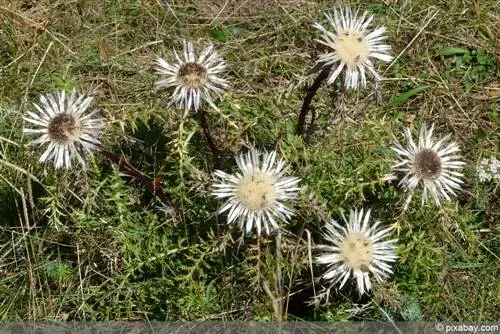
Basically you can do without it completely. However, there is nothing wrong with occasionally using organic products to provide an extra boost of nutrients. Untreated pond water, plant manure and compost are suitable for this. However, only in very small doses and at long intervals. Alternatively, some fresh soil can also be spread. Spring and summer are ideal times.
Culture in a bucket
Due to the quite compact size of the silver thistle, it can easily be cultivated in a pot. However, it should be noted that the container chosen must be as high as possible. Otherwise the roots cannot spread adequately in the substrate. It should be around 25 cm high. The easy-care culture differs only slightly from that in the bed. The only thing that becomes necessary is watering more often, as there is only a small supply available in the soil for the plant. For longer cultivation, the soil should be changed or the silver thistle repotted every two to three years. It's a little less work to fertilize in small doses every now and then. One or a maximum of two doses per year are completely sufficient. Repotting can then take some time until the soil appears used up.
Planting and sowing
The silver thistle plant can be planted or sown directly in the bed. Since it is relatively resistant to cold, it can be planted outdoors as early as April. However, for strong and rapid growth, pre-germination indoors is recommended. To do this, proceed as follows:
- A planter that is as high as possible is filled with potting soil and moistened well. The substrate should be consistently moist but no longer dripping.
- The seeds are placed on the substrate and pressed lightly. A thin covering of sifted substrate is also possible, but should only be done very finely.
- The planters prepared in this way are placed in a bright, slightly warm place. The temperature should be around 20°C.
- Until they germinate, the silver thistles are watered at small intervals and in small sips so that the substrate is consistently slightly moist.
- As soon as young plants are visible, the intervals between watering can be gradually increased.
- Once the plants have reached a height of around ten centimeters, they can be placed or planted outdoors.
Tip:
When moving into the bed or onto the balcony, you should choose a mild day so that there is not too much of a difference in temperature between the two locations.
Propagation
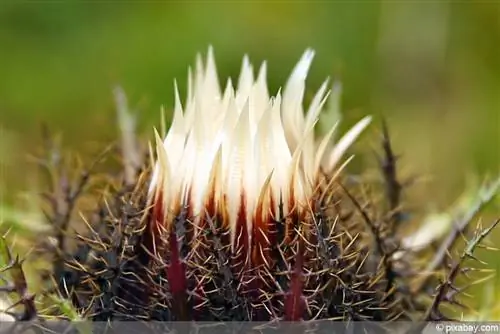
Nothing is actually necessary for propagation other than a little time and patience, because the silver thistle plant sows itself. Similar to dandelions, the light seeds can land in the immediate vicinity of the mother plant or in the farthest corner of the garden. Wind and animals spread the seeds quite efficiently. After successful germination, the plants can be dug up and placed in the desired location. Since they can be easily removed by pulling, an infestation is not to be expected. In addition, a very simple method of propagation is available. If you want to be a little more targeted, you simply have to place small bags over them before sowing the flowers and secure them in place. This way the light seeds will fall into the cover instead of spreading around the area. Pre-germination then takes place as described above.
Blend
Blending is not necessary for the silver thistle plant and does not make sense. However, it is entirely possible and advisable to remove damaged plant parts or use cut leaves for tea infusion. If you want to use the diuretic effect of Carlina acaulis, you should cultivate several plants for this purpose. This way the crop can be used for constant harvest and still enjoy the beauty of the plant.
Wintering
The silver thistle plant is inherently frost hardy and usually survives winter without any problems, even without further protection. However, the prerequisite for this is that it is in a suitable planting location. As already mentioned, a sunny and warm location is favorable. Additional protection from wind, such as a wall or house wall, is beneficial. In very harsh winters, the ground can still be insulated with mulch, straw or a layer of foil or fleece. However, the Carlina acaulis should not overwinter unprotected outdoors in a bucket, as it lacks the protection of a sufficient volume of soil. For small pots, the easiest way to overwinter is to bring them indoors. Here the silver thistle should be kept frost-free at a temperature of up to 10°C. It is important to avoid complete drying out of the soil. All you need to do is check the substrate weekly and water it little by little if necessary.
Conclusion
Undemanding and easy to care for, the silver thistle plant is not the most striking, but it is certainly an attractive eye-catcher. It can be cultivated just as easily in the rock garden, the planned flower bed or the natural garden as in the pot on the balcony. Thanks to its resilience, the Carlina acaulis is ideal for beginners and yet still has an unusual beauty.

